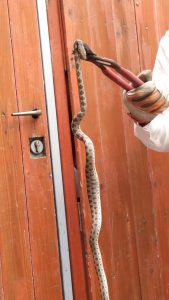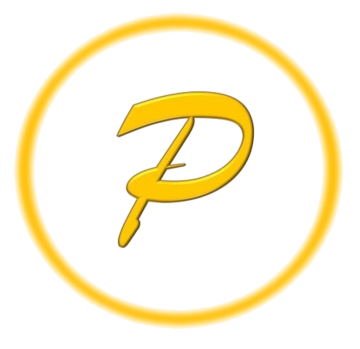A number of years ago on erev Shabbos of parshas ha’chodesh, I was doing some work in my yard together with my son when the latter suddenly exclaimed, “A snake!” Baruch Hashem, we experienced “he will smite you on the head” and not the other part of that pasuk[1].  But he didn’t go down easily. Despite having the flat edge of the shovel – I used a long handle shovel at first in order to maintain a safe distance – vigorously cutting right under its head for a solid five minutes, having its head smashed between said shovel and a wood fence multiple times, and then being iron-gripped with a pipe wrench pliers with bone-crushing pressure for about twenty minutes, it would still sometimes coil its body or open its mouth. About twenty neighborhood kids followed me to the local (retired) snake-catcher who confirmed that the reptile was venomous. He was quite perturbed that so many children were around and emphasized that even the slightest scratch from that creature’s teeth would require hospitalization. “Even for a bite from a non-venomous snake,” he added for good measure, “one would have to go to the hospital. Snakes carry dangerous bacteria which can go septic in the human blood stream within three days.” Really, if you suspect a snake is venomous, call a professional. And if someone c”v gets bitten: DO immediately call your local emergency number, remain calm and still, loosen tight clothing and jewelry, position the bite below or at heart level (lie down, if necessary), gently clean the wound, and apply a dry dressing. DO NOT flush the bite with water, use a tourniquet or ice, cut the wound or try to remove the venom, or drink caffeine or alcohol[2].
But he didn’t go down easily. Despite having the flat edge of the shovel – I used a long handle shovel at first in order to maintain a safe distance – vigorously cutting right under its head for a solid five minutes, having its head smashed between said shovel and a wood fence multiple times, and then being iron-gripped with a pipe wrench pliers with bone-crushing pressure for about twenty minutes, it would still sometimes coil its body or open its mouth. About twenty neighborhood kids followed me to the local (retired) snake-catcher who confirmed that the reptile was venomous. He was quite perturbed that so many children were around and emphasized that even the slightest scratch from that creature’s teeth would require hospitalization. “Even for a bite from a non-venomous snake,” he added for good measure, “one would have to go to the hospital. Snakes carry dangerous bacteria which can go septic in the human blood stream within three days.” Really, if you suspect a snake is venomous, call a professional. And if someone c”v gets bitten: DO immediately call your local emergency number, remain calm and still, loosen tight clothing and jewelry, position the bite below or at heart level (lie down, if necessary), gently clean the wound, and apply a dry dressing. DO NOT flush the bite with water, use a tourniquet or ice, cut the wound or try to remove the venom, or drink caffeine or alcohol[2].
Now, ever since the primordial serpent slandered Hashem and caused Chava and Adam to sin, the snake is the quintessential symbol of lashon hara, which of course is the primary cause of tzaraas. Lashon hara and snakes figure prominently in yetzias Mitzrayim. Because Dasan and Aviram informed Paroh that he had killed an Egyptian, Moshe Rabbeinu had to run for his life and concomitantly discovered the reason for the harsh slavery[3]. When Moshe argued that the Jews won’t believe him, Hashem bade him to throw his staff to the ground which became a snake, indicating he spoke lashon hara about Klal Yisrael[4]. The snake is the symbol of evil incarnate.
Yet, we find positive examples of snakes. Moshe and Aharon’s first demonstration to Paroh is the staff-turning-into-snake miracle. Snakes in dreams – particularly if it bites you – can indicate great parnassa[5] which is likened to Krias Yam Suf[6]; and in parshas Chukas[7] a brass serpent is the medium of healing and salvation! “The snake of down-below kills,” comments the Ohr Ha’Chaim, “whereas the snake of above heals”.
The Chofetz Chaim embodied a dichotomy of unmatched shmiras ha’lashon with verbosity. “What really is so incredible about him?” one Radin talmid even wondered. “After all, the Chofetz Chaim’s son-in-law, Rav Hirsch Levinson is apparently a greater tzaddik. He secretly gives up his meat for one of the destitute yeshiva bachurim. He painstakingly counts every word and speaks with extreme brevity. The Chofetz Chaim, though, is talkative and not nearly as exacting in articulation. So why is the Chofetz Chaim such a renowned tzaddik and not Rav Hirsch?” This anonymous talmid recounted that it was only later in life that it dawned on him: Giving positive expression to the power of speech is a much higher level than repressing it[8]. Undoubtedly, silence is a phenomenal middah[9], but higher yet is the flow of words that embody kedusha.
“In abundance of words sin is inevitable[10].” The primordial serpent was lowered and silenced. That is the nachash tachton. But there is a “snake of above”, a nachash elyon. Ultimately, the yeitzer hara is a tool for avodas Hashem[11]. “The right way for people who love talking all the time,” says Rabbeinu Yonah, “is to harness that penchant for their benefit with an endless flow of divrei Torah, wisdom, mussar, bringing peace between people, expressing merit for the many, praising goodness, decrying evil, and defending truth. This way, he can acquire endless merits for himself with his tongue[12].”
To kill a snake is tough and quashing insatiable talkativeness can loom impossible. Everything exists in parallelism[13]. There is a
[1] Breishis 3:15
[2] Recommendations of Mayo Clinic
[3] Rashi Shmos 2:14
[4] Ibid 4:3
[5] Brachos 57a
[6] Pesachim 118a
[7] 21:5
[8] Sefer Chofetz Chaim, Introduction
[9] Avos 1:17
[10] Mishlei 10:19
[11] Brachos 54a
[12] Shaarei Teshuva 3:210
[13] Koheles 7:14
